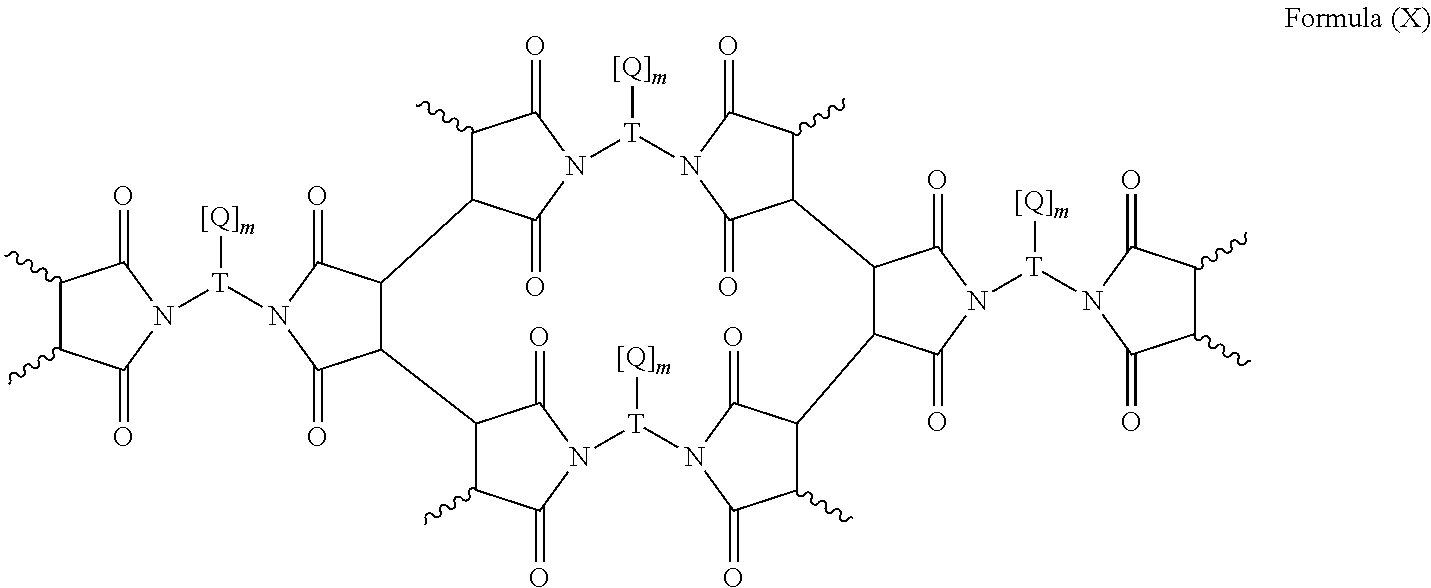Liquid crystal alignment film and liquid crystal alignment element using the same
a liquid crystal alignment film and liquid crystal alignment technology, applied in the field of liquid crystal alignment agent and liquid crystal alignment film, can solve the problems of poor reliability of using polyamic acid as liquid crystal alignment agent, inferior coating ability, and easy defect of precipitation on the alignment film, etc., to achieve superior reliability, superior coating ability, and superior voltage holding ratio
- Summary
- Abstract
- Description
- Claims
- Application Information
AI Technical Summary
Benefits of technology
Problems solved by technology
Method used
Image
Examples
synthesis example 1
[0081]A 500 ml four-necked conical flask equipped with a nitrogen inlet, a stirrer, a heater, a condenser and a thermometer was purged with nitrogen, and the components shown in Table 1 were charged to the flask. The aforementioned components comprising 3.76 g (0.01 moles) of 1-octadecyloxy-2,4-diaminobenzene (hereinafter abbreviated as C18DA), and 50 g of a solvent of tetrahydrofuran (hereinafter abbreviated as THF) were stirred at room temperature until dissolved, after which 2.45 g (0.025 moles) of maleic anhydride (hereinafter abbreviated as MAn) is added and left to react for 3 hours at room temperature. After the reaction was finished, the reaction solution was filtered, and the solid obtained therefore was repeatedly washed using THF and filtered three tunes, and then placed into a vacuum oven, where drying was carried out at 60° C., thereby obtaining a compound containing 2 maleamic acid groups (A-1-1).
Synthesis Examples 2˜8
[0082]The operating procedure of Synthesis Example ...
example 1
[0096]100 parts by weight of the maleamic acid group compound (A-1-1) obtained from Synthesis Example 1 was dissolved in a cosolvent of 1200 parts by weight of N-methyl-2-pyrrolidone (hereinafter abbreviated as NMP) / 300 parts by weight of butyl cellosolve (hereinafter abbreviated as BC) and allowed to completely dissolve at room temperature. The alignment agent solution obtained was coated onto a glass substrate provided with an ITO (indium-tin-oxide) film using a spinner, after which pre-bake was carried out on a hot plate at a temperature of 80° C. for 2 minutes, and post-bake was carried out in an oven at a temperature of 235° C. for 15 minutes. The film thickness was measured to around 750 Å using a film thickness measuring device (manufactured by KLA-Tencor, Model Alpha-step 500). Two glass substrates having the liquid crystal alignment film were manufactured by the aforementioned steps, thermo-compression adhesive agent was applied to one glass substrate, and spacers of 4 μm w...
example 2
[0097]The operating procedure of Example 1 was repeated, except that the kind and dosage of the maleamic acid group compound (A) were changed. Details and evaluation results were shown in Table 2.
PUM
| Property | Measurement | Unit |
|---|---|---|
| angle | aaaaa | aaaaa |
| angle | aaaaa | aaaaa |
| structure | aaaaa | aaaaa |
Abstract
Description
Claims
Application Information
 Login to View More
Login to View More - R&D
- Intellectual Property
- Life Sciences
- Materials
- Tech Scout
- Unparalleled Data Quality
- Higher Quality Content
- 60% Fewer Hallucinations
Browse by: Latest US Patents, China's latest patents, Technical Efficacy Thesaurus, Application Domain, Technology Topic, Popular Technical Reports.
© 2025 PatSnap. All rights reserved.Legal|Privacy policy|Modern Slavery Act Transparency Statement|Sitemap|About US| Contact US: help@patsnap.com



